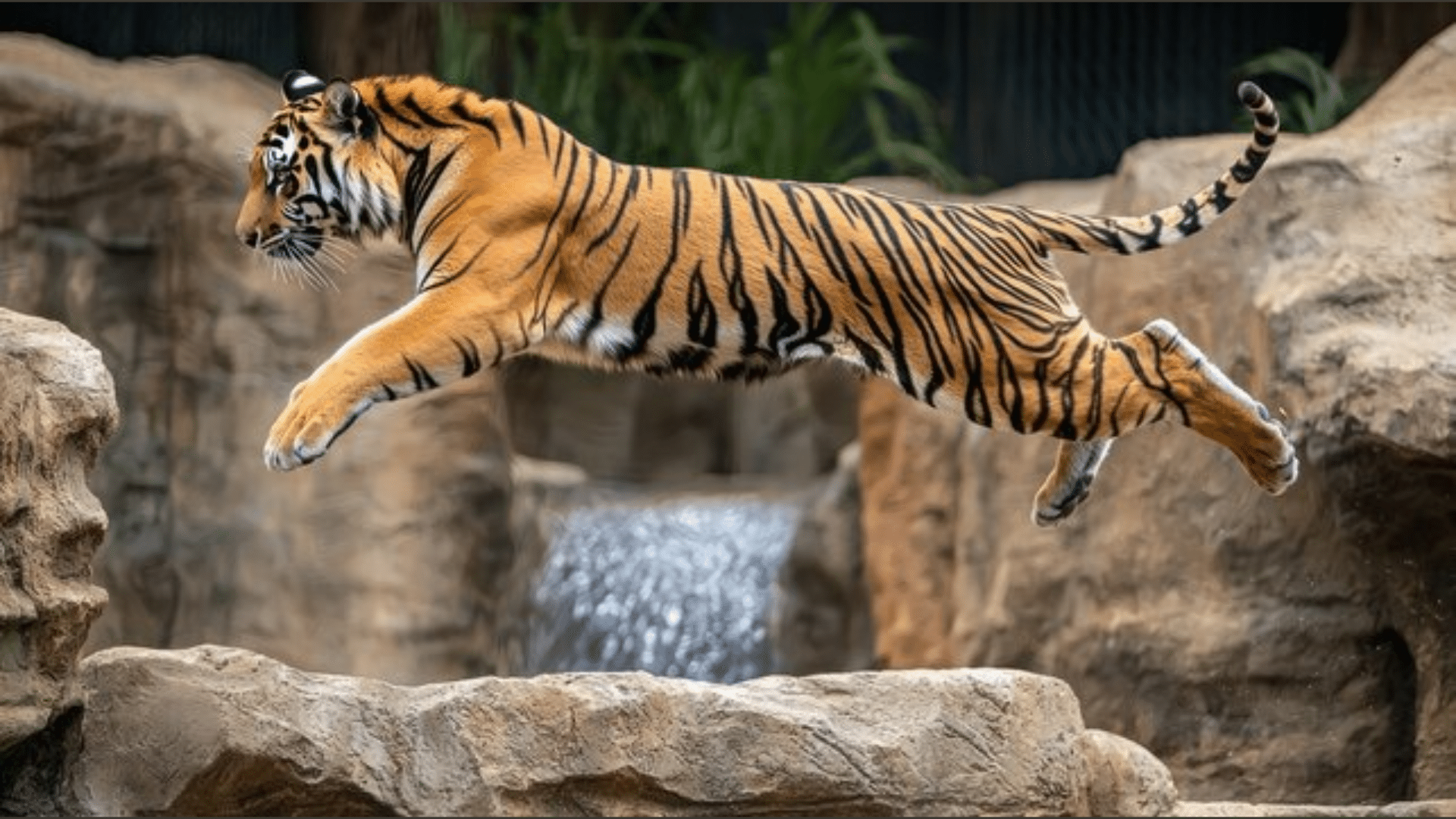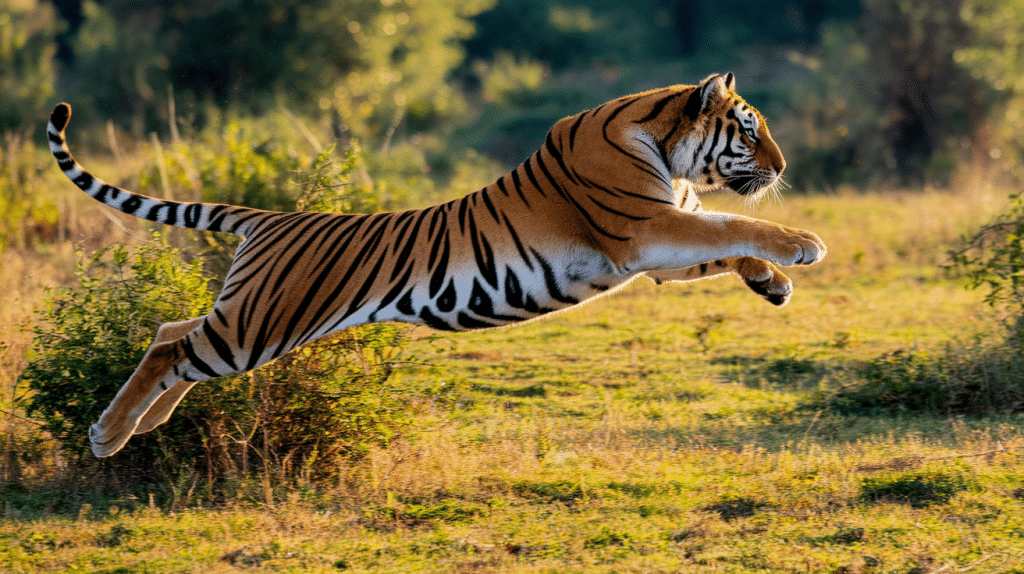Tigers are known for their beauty and strength, but one ability often surprises people: their jumping skills. You might not expect such a large animal to leap with ease, but tigers can.
Whether moving through thick forests or chasing something quickly, they use their body in smart and powerful ways.
Well, this blog isn’t just about how high or far they can jump; rather, it looks at the different things. Mostly, that helps them leap, how their environment shapes their movements, and what sets each tiger apart.
So, before discussing whether tigers are really powerful, let’s learn in detail about how high they can jump.
How High and Far Can a Tiger Jump?
Tigers are remarkable jumpers and are capable of impressive feats both vertically and horizontally.
- Vertically, a tiger can leap up to about 16 feet (approximately 5 meters) into the air, which is enough to easily clear very tall obstacles, such as the height of an elephant’s head.
- Horizontally, tigers can jump forward around 25 feet (about 7.5 meters) in a single bound, comparable to leaping over a large vehicle or a wide gap.
These powerful jumps are important for hunting and moving through rugged terrain, relying on the tiger’s strength, timing, and muscle control.
This combination of strength and agility makes the tiger one of the most powerful jumpers among big cats.
What Makes Tigers Such Powerful Jumpers?

Tigers have a natural body design with their powerful hind legs longer than their front ones, which allows them to spring forward with intense force.
However, combine that with a flexible spine, strong muscles, and claws for traction, and there’s serious jumping power at play.
Every muscle works together to help launch them forward or upward. Additionally, their low center of gravity provides excellent control in mid-air.
They don’t need momentum or a running start, just a quick crouch, and they’re off. Tigers rely on stealth, power, and surprise, so their jump is often their best opening move.
Which Tiger Jumps the Highest?
Here is the list of how each tiger species uses its strength, speed, and agility to jump to incredible heights and distances.
- Bengal Tiger: Highly athletic and balanced, Bengal tigers use their coordination to launch sudden, precise jumps while stalking prey through dense grasslands.
- Siberian Tiger: Despite their size, Siberian tigers survive in snow, using strength and endurance to leap across icy terrain with quiet, calculated power.
- Sumatran Tiger: Adapted for dense rainforests, Sumatran tigers perform nimble, upward leaps, often using tree roots and logs as springboards during hunts.
- Malayan Tiger: With quick reflexes and lean frames, Malayan tigers excel at darting jumps in tight jungle spaces where ambush timing is crucial.
- Indochinese Tiger: These tigers leap with speed during ambushes, often bounding through underbrush to catch prey off guard.
Wild vs Captive Tigers
| Factor | Wild Tigers | Captive Tigers |
|---|---|---|
| Jump Height | Up to 12 feet | Around 8–10 feet |
| Physical Condition | Lean, muscular, and well-conditioned | Can gain weight or lose muscle tone |
| Daily Activity | Regular hunting, roaming, and climbing | Limited movement, less physical stimulation |
| Reason for Difference | Constant activity keeps muscles strong and agile | Less challenge reduces strength and flexibility |
Factors That Affect a Tiger’s Jump
Every tiger jump isn’t a one-size-fits-all kind of move; several factors decide just how high or far that leap goes.
- Age: Young tigers are still growing, while older ones lose some of their explosive power.
- Health: Illness or past injuries can reduce strength and flexibility.
- Motivation: A hungry or threatened tiger will leap with more urgency and energy.
- Surface Type: Snow, mud, or dry soil affects grip and jumping traction.
- Weather Conditions: Rain or wind can impact balance and takeoff.
- Diet and Nutrition: Proper protein and fat fuel those powerful leg muscles.
Some Interesting Facts About Tiger Jumps
Let’s look into a few more wild and unexpected tiger jump facts that didn’t make it into the main spotlight earlier.
- Tigers can twist their bodies mid-air to adjust landing angles, especially useful when leaping across uneven terrain or obstacles.
- During territorial fights, tigers often jump sideways to dodge and counterattack with speed and precision.
- Jumping is also a key part of tiger mating displays; young males may leap around to show off strength and agility.
- In some cultures, a tiger’s leap symbolizes courage, power, and spiritual dominance in local folklore and myths.
- Long-distance jumps are typically made with minimal sound, making their approach almost silent and giving them an advantage in stealth.
Wrapping It Up
Tigers don’t just walk or run; they leap with purpose. Their jumping isn’t just for show; it’s a smart way they use to survive and progress.
However, from climbing over barriers to catching prey, every jump has a reason. Things like age, health, and weather can make a big difference in how far or high they go.
Ultimately, wild tigers tend to jump better than those in bondage, simply because they stay more active.
So, it’s clear that tigers can really jump high and each leap serves an important purpose in their natural behavior.















